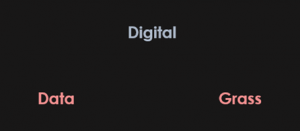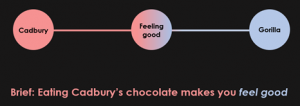Great advertising often has the uncanny ability to make unique and meaningful connections in what it creates. From gorillas and chocolate to beer and frogs, advertising joins the dots in a meaningful way that can seem initially unrelated.
To dismiss these ideas as random or simply novel would be doing them a disservice. Our emotions tell us that it’s working, but our minds can’t quite explain why. To better understand why these “random at face value” ideas work so well, I’d like to introduce the concept of semantic distance.
What is semantic distance?
When we talk about semantic distance, we are referring to how closely related an idea, concept or object is in relation to another in its meaning. It’s abstract, but it’s something we use every day.
We humans are incredibly good at assessing semantic distance, often implicitly working out the relationship between concepts and ideas on the fly.

For example, if we take the above choices of data and grass, you should be able to quickly discern which term is closer to the word digital (spoiler: it’s not grass).
Where does creativity come into it?
Creativity may seem far removed from understanding memory and association, but emerging research has shown how we retrieve memories and make connections can have a big impact on creative output. Being able to generate terms which are related, but semantically distant is a good predictor of creativity in individuals (Olsen et al., 2021).

This ability to skip A to B reasoning and jump straight to A to Z can prove invaluable for generating unique ideas and meaning. Taking two seemingly unrelated ideas and post-rationalising how they connect fosters unique storytelling and new ways to illustrate values and ideas. In the advertising world, it can give us new fuel to craft stories that feel congruent with the brands we tie them to.
Bridge the Associative Gap task
One simple way to retroactively assess this skill is called the Bridge the Associative Gap Task (psychologists are not known for their snappy naming ability). In this task, we present a person with two seemingly unrelated terms, and ask them to provide a connection in the middle which links the two. The greater the semantic distance these terms have, the more challenging this task may prove for people.


In the above example, the distance between Giraffe and Scarf might be quite large, but neck works well as a term that connects the two in a unique way. Advertising typically deals with more complex ideas and themes than single-word terms, but the same model can be applied to the big ideas we see in our world.
How does it work for us?

If we take Cadbury’s famous Gorilla spot, the link between Cadbury and drum soloing gorillas seems tenuous at best. However, once we understand the brief given to the agency, the picture becomes clearer.

“The whole business had become quite earnest and serious, when in fact it’s chocolate and should be more about things such as Willy Wonka. The brief I gave the agency was: Eating Cadbury’s chocolate makes you feel good.”
– Phil Rumbol, Former Marketing Director at Cadbury
Operating within the remit ‘it makes you feel good’ allows creatives to draw semantic links between Cadbury’s chocolate and other seemingly unrelated ideas in a way that resonates with our irrational, emotional brains.
This came through in the pretesting of the campaign. Qualitative researcher Mark Ratcliff ran a number of focus groups on the concept, saying “The majority of respondents were nonplussed or confused. However, a minority were so passionate that I turned the volume up on their responses”. This decision to hedge bets on the voices of those with an irrational joy and love for the work proved to be the right risk to take, with its undeniable success.
It doesn’t make rational sense on the surface, but it just so happens that eating Cadbury’s chocolate and watching a gorilla play Phil Collins on the drums both make us feel good. This level of lateral thinking can be the hallmark of a great campaign.
Conclusion
Despite much of this research endeavouring to place structure and understanding around creative idea generation, the overwhelming takeaway for us is the refreshing degree of freedom it offers creatives in what they can tether to brands and campaigns.
Understanding that connections can be emotional and implicit allows us to stave off direct comparison and opens the door to story, allegory and metaphor – a place where creativity can thrive, and ideas can flourish.





